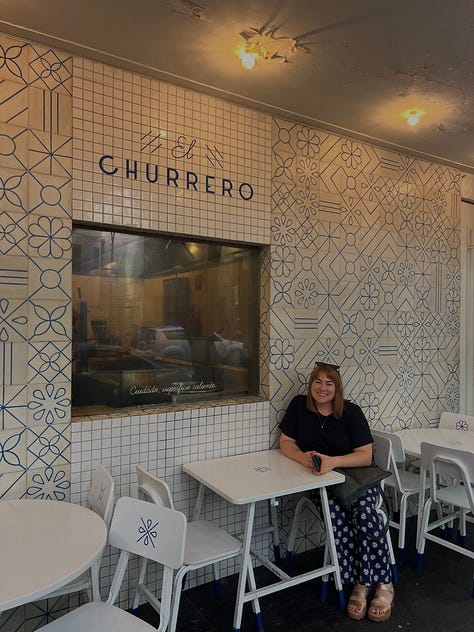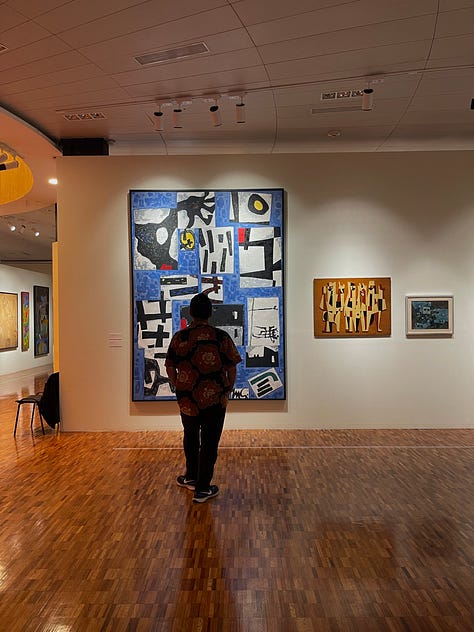Our Trip to Mexico City 🇲🇽
Even though it was our first time in Ciudad de México (CDMX), the city had a way of making us feel like we’d been there before.
The city felt strikingly familiar, despite it being our first visit to CDMX. Salih and I kept noting how much it reminded us of İstanbul. We didn’t expect to find such a cozy sense of déjà vu when we celebrated our five-year wedding anniversary in Mexico City—a place bursting with inspiration, creativity, lush greenery, inviting flavors, and cultural warmth.
Our week there was magical, which feels like a good omen of what’s to come in the next five years of marriage. It quickly claimed a spot as one of our top vacations, with food taking center stage. Tacos, tamales, and tetelas—maize, or corn, was the unsung hero of every delightful bite.
Maize is a vital food crop, with colorful kernels on a cob, snugly wrapped in a husk. But maize isn’t just a staple; it's woven into the very fabric of the land’s history and survival. While often used interchangeably, both "corn" and "maize" can have different meanings depending on the region and their historical evolution.
Through the ancient Mesoamerican process of nixtamalization, maize became more digestible and its nutritional value was more available to consumers. Nixtamalization is the process of soaking maize kernel in water mixed with an alkaline solution, either wood ash or food-grade powdered limestone. Once discovered—though the method of discovery remains a mystery—human development evolved. This evolution brought with it incredible innovations, such as those seen in Mexico City.
One of the most fascinating features of Mexico City is the pre-colonial canals of Xochimilco, where chinampas have been cultivated for centuries to produce food. A chinampa is a Mexican “artificial garden,” created by piling soil dredged from a lake or pond onto a mat of twigs. These man-made islands were developed by farmers 200 years before the Aztec Empire came to power in the region. Although often overlooked today, chinampas are crucial to the city’s food culture and growth. Interested in learning more about chinampas? Check out this article.




I’m just scratching the surface of the city's rich food history and culture, not to mention that of the country as a whole. However, our week in Mexico City has sparked an insatiable curiosity about its culture, so we’ve compiled a list of restaurants, events, and must-dos to help you dive right in. To kick off your exploration, I highly recommend starting with a tour from Culinary Backstreets. Understanding CDMX’s history through its agriculture and access to water and food resources provided invaluable context and set us up for a successful week ahead.









Jo and Salih’s 2024 CDMX Guide
Food:
Odette: My absolute favorite bakery—possibly in the world! The Condesa location is nestled in a peaceful neighborhood. Whether you bring a book or just people-watch, this is the place to be. Everything on the menu is delightful, but the kouign amann frambuesa is truly exceptional. To learn more about Odette's story, check out this podcast.
Los Panchos: This welcoming restaurant offers a range of dishes, including carnitas, mole, soups, and tacos. A favorite among locals, it’s consistently busy with a fast table turnover.
Orinoco: With three locations in CDMX, this place might have served one of my favorite bites of the trip. It combines the vibe of a taco joint with a 1950s American diner. Order at the counter and be sure not to miss the al pastor and chicharrón tacos—they were exceptional.
Molino "El Pujol": A fast-casual alternative to Pujol, Molino “El Pujol” serves up unique and delicious bites like Taco de Aguacate and Tamal de Mango (both pictured above).
El Moro: Founded in 1935, El Moro boasts several locations throughout the city and is renowned for its delicious churros and hot chocolate. You might even see the fresh churros being made right before your eyes.
Panadería Rosetta: This spot is extremely popular, and for good reason. You’ll enjoy fantastic pastries and might even spot Instagram influencers posing with gusto. If you value your sanity, it's best to skip visiting on the weekends.
Guzina Oaxaca: We discovered this hidden gem for a delightful afternoon snack. Fresh masa and tortillas were being prepared right in the front, making maize the star of the menu. We sampled a squash blossom tetela— a triangular masa pocket stuffed with cheese— and it was perfect. I’m sure dining here for dinner would be an equally memorable experience.
Restaurante Rosetta: As a one-star Michelin restaurant, our experience was delightful. With a menu inspired by Mexican, French, and Italian cuisine, it was eclectic. Arrive early and grab a seat at the bar—it's stunning and ornate.
Maizajo: This restaurant is an absolute must-visit. You can either make reservations for the dining area upstairs or grab a spot at the taco bar below, where the menu changes daily. We chose to sit upstairs - the shrimp taco and duck barbacoa taco were truly exceptional. The duck barbacoa taco was Salih’s favorite bite from the whole trip.
Café El Jarocho is a great place for breakfast in Coyacan. Near the Frida Kahlo Museum, this is a great place for coffee and tortas. Order at the counter and take a seat on the benches lining the sidewalk.
Tlecan Bar: This high-end bar exudes a moody, dark ambiance reminiscent of an ancient tomb. It specializes in cocktails with a mezcal twist, offering a unique and refined drinking experience. For a memorable bar snack, try the roasted crickets—crunchy, tangy, and spiced to perfection.
Restaurants I wish we had time to try:
Cana was repeatedly recommended to us by CDMX locals.
Mi compa “Chava” for amazing casual seafood.
TETETLÁN near the Casa Estudio Luis Barragán.
Pasillo De Humo for more tastes of exceptional Oaxacan food.
Restaurante Contramar for upscale seafood.
Events:
Culinary Backstreets: The City Green: Discovering Xochimilco’s Urban Eco-Reserve. This experience was absolutely fantastic. On our second day, it set a perfect tone for the rest of our trip. We gained valuable insights into the city and got a fantastic sense of its layout!
Ballet Folklórico de México at the Palacio de Bellas Artes. The theater is stunning, and dancing is mesmerizing. Mexican folk dance is so intertwined with the nation’s culture that no matter the style, each performance reveals a unique slice of Mexico's soul.
Lucha Libre at Arena México. A rowdy experience that won’t break the bank, Lucha Libre is all about unfiltered joy and performance. Show up ready to laugh, cheer, and enjoy a beer with a tangy tajín twist.
Other Things to do:
Bike around the parks; it is easy to rent bikes all over the city.
Explore the Mercado Coyacan near the Frida Kahlo Museum.
Visit Museums: Anthropology, Modern, Frida Kahlo, Castillo de Chapultepec.
Take a day trip to the pyramids of Teotihuacan.



In the next issue of Hasat, I'll be sharing a recipe for making Lahmachun at home, and we'll return to our usual content. Thank you for joining me! I'd love to hear if you've ever been to Mexico City or if you’re planning a visit soon.





Love your writing! I can see why you loved CDMX - it’s one of my top food travel destinations too 😊